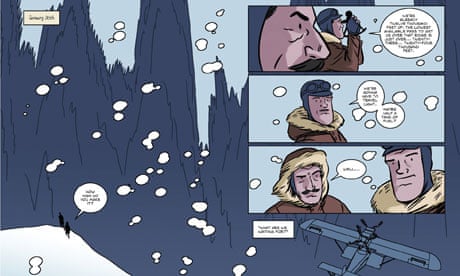The American writer HP Lovecraft, who died in 1937, has been called "the man who scares Stephen King". A writer of horror and science fiction, Lovecraft's guiding principle was that the universe is incomprehensible and terrifyingly alien, and that there somewhere exists an abyss which, should we have the misfortune to gaze into it, will rob us for ever of our sanity. Many of his books feature a grimoire (my favourite word ever) called the Necronomican, which was written eons ago by a man called Abdul al-Hazred in Sana'a, Yemen. Spooky, eh?
Lovecraft isn't easy to read; his language is archaic and convoluted, and you might not know half the time what he is going on about. Happily, however, one can now experience his eccentricities, his pessimism, and his daring without having to wade through his prose: Lovecraft's 1936 work, At The Mountains of Madness, has just been published in the form of a graphic novel, written and drawn by INJ Culbard, whose adaptation of the Sherlock Holmes story, The Sign of the Four, I raved about earlier this year. The story is a strange one – there are pod-like creatures with foul-smelling green blood, and giant, eye-less, waddling penguins – but losing yourself in it is pure pleasure.
It is not only that Culbard has so cunningly boiled down Lovecraft's rather weighty novel, leaving its exciting plot free to breathe; it's also that his superb ligne claire drawings so effortlessly evoke both the world of Tintin, and the Edwardian science fiction of HG Wells and Sir Arthur Conan Doyle. If you are a fan of the golden age of polar exploration – if you still hanker after Boy's Own stories of derring-do – I promise that this is the graphic novel for you.
But it's not all pristine snow and leather goggles. The sickly Lovecraft, who died when he was just 47, suffered from terrible night frights, and had an almost pathological fear of the cold; his Antarctica is more inhospitable than most. Our team of scientists, led by the splendidly moustached Professor Dyer, have no sooner hit the ice pack than weird things begin to happen. When the team's huskies begin to bark uncontrollably, you know no good will come of it – and sure enough, in a nearby ice cave, the men find 13 40 million-year-old tentacled blobs whose discovery they believe will completely rewrite biology. I'd better not say what happens next, but it is grim, with hot splashes of red suddenly staining the cold greens and blues of Culbard's palette.
What I will tell you, though, is that I loved reading this book, with its gorgeous jacket and end papers (snow, mountains, two tiny wandering figures; this fairy story image gives one an entirely false sense of security). For the scant half hour it took me, I was completely transported. I read it late at night, in my pyjamas, and it was great. I felt like a kid again.

Comments (…)
Sign in or create your Guardian account to join the discussion